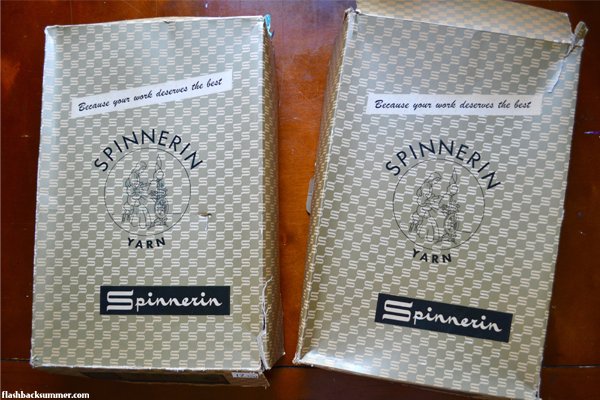

Oh wait, it's also in it's original packaging.
And in the original box.
With the original company invoice.
And the invoice is dated with the year 1964.

Yes, it is very awesome! Two boxes were found in a closet, both from the Spinnerin yarn company and full of amazing yarns imported from Switzerland.
I did some research on the Spinnerin company, and it was started in the early 1950s. The company produced yarn and patterns until 1982 when it closed down. They were located in Hackensack, New Jersey. Aaaannndddd.... That's pretty much all I could find that wasn't a pattern, believe it or not.
The yellow yarn is a 100% viscose yarn that seems thinner, perhaps a fingering weight yarn. Viscose is made of cellulose from plant fibers and is closely related to rayon. There are only a few skeins of this one, but it's very soft, and Spinnerin guaranteed the yarns would match if dye lot numbers were the same!

The other yarn is from a "Ski sprint" yarn, one I'm guessing that was especially intended for winter wear. It's a thick, worsted weight yarn (according to this chart) in a cream color. It's 19% mohair, 75% virgin wool, and 6% rhovyl-vinyon. The boxes seem to coordinate with this yarn type and says it is protected by Scotchgard to make it stain and water-resistant.

In case you're like me, I needed to look up a couple of these fibers to be sure I knew what they meant:
(These are my paraphrased definitions.)
mohair - made of angora goat fur, sometimes mixed with wool
virgin wool - yarn made of wool spun for the first time, as opposed to skanky recycled wool (heh heh).
rhovyl-vinyon - this yarn explanation gets real science-y real quick. (For a more complete description, you can read about it here on pg. 71.) Basically, it's a synthetic fiber that provides weather-resistant and insulating properties to the yarn.

Now you all must be wondering... What will you make with all this yarn, Emileigh?
To answer you... I don't know yet. There isn't very much of the yellow, and you have to be careful with discontinued yarns. If you get into the middle of a project and realize you don't have enough, you're pretty much screwed. I'm going to look at a bunch of patterns and try to do some math before deciding on a project. If you have suggestions that you think would work for this amount and type of yarn, I'd love to hear them!

Other resources:
Spinnerin knit & crochet patterns
Spinnerin yarn chart








What a great find and in their original boxes too! Wow, can't wait to see what you end up making with this fabulous yarn.
ReplyDeleteOh my goodness is that yellow actually called "squaw valley sky?" Oh the 60s.
ReplyDeleteBut congrats on the yarn find! :-)
-- Tegan
I think the yellow is in a box for a different yarn and is actually called "desiree,"... but, yes, I think SOME yarn was called that. So dumb. What color would that even be?! It doesn't even make sense!
DeleteAbout a year ago, I thrifted a ton of Ski Sprint in emerald green, and I have also been trying to figure out what to make with it! I have found a few patterns in Spinnerin pamphlets that call for this yarn, but I'm not usually a big fan of 60s knitwear since it is often not as fitted as I would like. The texture of the Ski Sprint makes me think it would work well for a short 1940s workwear jacket without any fancy stitchwork.
ReplyDeleteThanks for the article. I've just started researching Spinnerin I believe they started here in the U.S in the early 1940's with their products from a mill in Switzerland. I've also seen them referred to as a Trader. I have one of their pattern books - No 108 - that is dated 1947 and there were several issued before that.
ReplyDeleteThat's interesting! That explains why it says "imported from Switzerland" on it!
Delete